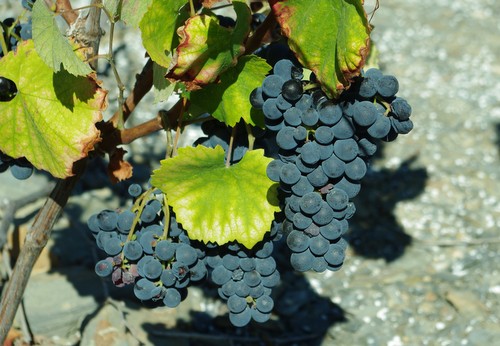I posted a couple of days ago about hyperselection, and whether or not this was a good thing in red winemaking.
At lunch yesterday I had a discussion with Elizabeth Vianna, winemaker at Chimney Rock in California’s Napa Valley. This vintage, for the first time, they hired the latest-generation optical sorter for a trial. This proved very effective at removing stem jacks (small pieces of green stem), and the trial wine had a very pure fruit character to it.
But Elizabeth felt that the wine with the stem jacks had a bit more complexity. She suggested that some winery owners might be more impressed by the wine made by hyperselection, but this might be a simpler wine that doesn’t age as well.
This led me to think about whether or not there needs to be any compromise in early drinkability if you are making a wine for ageing. Is it possible to make a wine that tastes great young and ages brilliantly? Or is a wine with amazing ageing potential a little less generous, and a bit more structured and tighter in its youth?
Francois Mitjavile, I suspect, would argue that his wines, with the smooth, soft tannins and higher than normal pH, taste great young and have the potential to age very well, too. His view is that overly tannic wines don’t age well. This is interesting: I would have thought that tannin modifications take place on the vine, and picking late develops tannins to the point where their astringency is diminished. The process of elevage and bottle ageing also develops tannins. And the perception of tannins will be altered with pH. One of my theories is that low pH causes increased salivary flow, which means more salivary proteins precipitate tannins and therefore increase the sense of astringency and structure in a red wine.
I’m not so sure. For example, I love red wines made with stems (whole cluster ferments), which I guess is the opposite of hyperselection. They are sometimes difficult young, but age really nicely. And I’ve recently drunk a lot of old Rioja: one producer, commenting on the ‘improvements’ they have recently made to their wine (making it much fruitier and soft at a young age), suggested that the very old wines he was showing would have been difficult to drink on release.
I think this is such an important question for the fine wine world. People are buying delicious young Bordeaux wines for serious money, and they are being traded and not drunk, stuck in large warehouses, with the expectation that these top wines will age for 50 years. What would happen if it turned out that modern Bordeaux is a 15 year wine, not a 50 year wine?
6 Comments on More thoughts on selection, and does ageability require compromise?



Good points here and in your post last Jamie. I am also wondering whether these optical sorters and Mistrals etc. are the best way to make good wine and if they are really worth the cash. And with increased sorting there is also the question of what do you do with the bits that don’t make the cut. Depending how you sort, is your 2nd wine now just that little bit worse..?
Also you can’t just buy a Mistral and plug it in, it takes a lot of work and careful attention from someone who really knows what they are doing to get the best results. I’ve seen some wineries who just seem to buy all the expensive toys but then maybe don’t take enough time to make sure they are used properly all harvest.
As for the bit about perfectly round ripe wines, ageing well or not, guess it’s a bit early to say. It’s not 50 years, but I did recently go to a vertical tasting of Roda I (made with a lot of vineyard selection and sorting). The oldest wines were 1994 and 1995 and these were certainly holding up amazingly well with plenty of life ahead of them.
The role of pH and astringency is certainly an interesting area of investigation. Saliva flow has a role to play in astringency (see my poster here http://www.plumpton.ac.uk/Upload/Documents/Departments/wine/research/research-saliva-poster-final.pdf) as does pH and acidity. It seems when looking at simple cases if pH increase flow, astringency is diminished. However as changing pH influence the the behaviour of proteins (due to isoelectric point) it could be that binding capacity of the saliva changes.
A great wine that drinks well when it’s young AND ages well seems to be asking too much from the universe! or from the grapes, vines, vineyards, and soils. Intuition and common sense suggests (to me) that something has to give somewhere!
A great
Jamie – also note that this is only the first impression
on these very young 2013 wines. It will be interesting
to follow the development of these wines in
many years to come and see if those stem jacks
do in fact add longevity to a wine.
Another great topic! These ideas have been the centerpiece of my premium wines buying strategy for many years. 2/3 of my cellar is made up of moderately priced red and white wines of good value. The other 1/3 is reserved for more expensive, special red wines. So, just what constitutes a “special” wine for a premium price? It has taken me 20 years of collecting wine and an evolving palate to finally arrive at a couple of answers: 1. Wines with structure and balance, that are complex, BUT ALSO accessible after 5 years. 2. Wines that my loved ones and friends enjoy and I can share.
IMHO, the holy grail of wine is the 1st category (as suggested in your post). Examples for me would be Barolo, Southern & Northern Rhone (and “Rhone Style”) and mountain fruit Napa cab sauv (Veeder, Spring & Howell). Yeah, I know… no classified growth Bordeaux & cru Burgundy. How do you justify $150+/btl when you have a budget? An example in the 2nd category is expensive champagne. Not what I personally would spend big dollars on, but I really enjoy sharing good bubbly with friends who appreciate it!